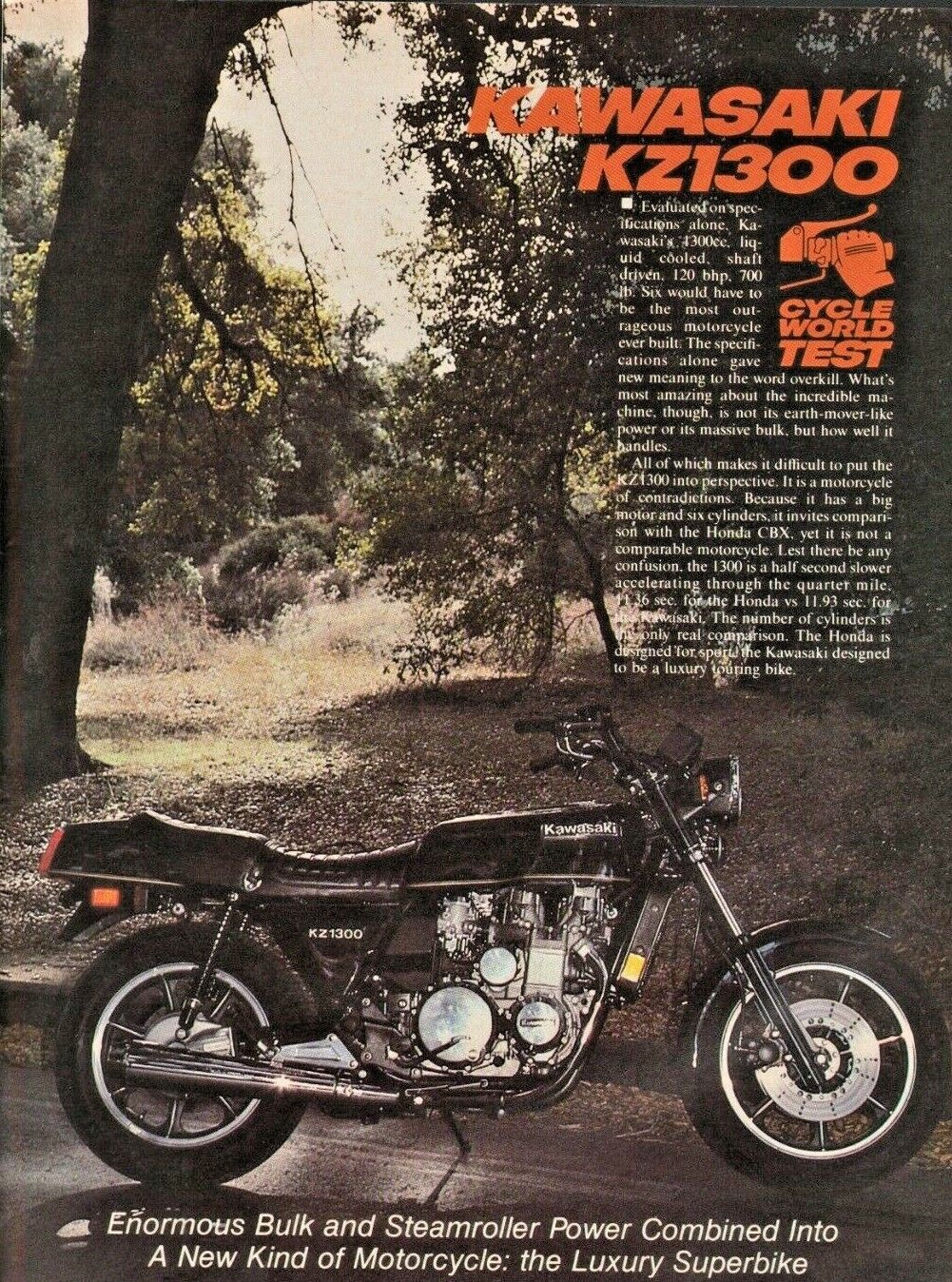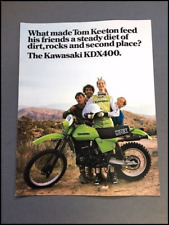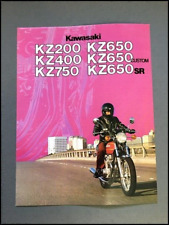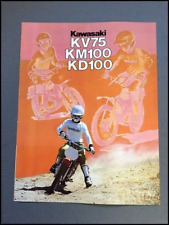When you click on links to various merchants on this site and make a purchase, this can result in this site earning a commission. Affiliate programs and affiliations include, but are not limited to, the eBay Partner Network.
Yes we combine shipping for multiple purchases.Add multiple items to your cart and the combined shipping total will automatically be calculated.
1979 Kawasaki KZ1300 - 8-Page Vintage Motorcycle Road Test Article
Original, vintage magazine articlePage Size: Approx. 8\" x 11\" (21 cm x 28 cm) each pageCondition: Good
...There are comparisons to be made, butnot with the CBX. Instead, the 1300 couldbe compared to the Honda Gold Wing orYamaha’s XS Eleven, both big, refined,heavy touring bikes made for long dis-tances on open roads with big loads.The Kawasaki is that kind of bike. Onlybetter.Beginning in June, 1973, Kawasaki en-gineers began work on Model 203. whichwas to become a luxury high performancemotorcycle. Various engine configurationswere initially considered but the motorcy-cle was to have 1200cc and a shaft drive.The original 900cc Z1 had been intro-duced the year before and the sport marketwas considered well covered.Six cylinders was considered the max-imum number for the engine size and hadan undeniable market appeal. At thattime, the Benelli Sei hadn’t been intro-duced and the only Honda with six cylin-ders had been a GP racer made in aprevious decade. While a V-Six. like theLaverda endurance racer, could be morecompact, Kawasaki had more experiencewith inline engines and could design aninline Six sufficiently compact to fit amotorcycle.That\'s where the liquid cooling comesin. Although an inline Six. with cylinderslined up across the frame, could be aircooled adequately, liquid cooling couldmake the engine more compact becauseless room is needed between cylinders.Liquid cooling, of course, also has meritfor touring bike use: it insulates againstmechanical noise, making the bike qui-eter; it increases longevity through precisecontrol of operating temperature; and itallows more efficient running by holdingtemperatures constant and higher undernormal operation than is possible with anair cooled engine.Because the Six was to be a touring bikeinstead of an all-out sport bike, the designis compromised more toward touring thansport in a number of ways. Because ulti-mate power potential wasn\'t needed, theengine is decidedly undersquare with a62mm bore and 71mm stroke. An over-square engine has more piston area, moreroom for valves and lower piston speeds,all of which contribute to higher horse-power, but the undersquare engine is nar-rower and, all other things being equal,produces more low-end and mid-rangepower. Just the ticket for a louring bike.Most of the design innovations narrowthe engine across the cylinders and head,rather than at the crankshaft. WhileHonda moved the alternator and ignitionbehind the crankshaft to keep the bottomof the CBX Six narrow for improved cor-nering clearance, Kawasaki left the alter-nator on the right end of the crankshaftand mounted a torsion damper/flywheelon the left end of the 1300’s crankshaft.The weights help balance the Sixes’ cycli-cal vibrations but don’t help corneringclearance.To keep the crankshaft short, there’sonly one drive chain, a 32mm Hy0Vo.which drives a jackshaft directly behindthe crankshaft. There is no cam chain fromthe crankshaft. Instead, a 10mm Hy-Vochain runs from the jackshaft to drive bothcams.The incredible sophistication of the1300 is apparent in the drive system. Oncepower is transmitted to the jackshaft, itgoes in two directions. To the right side, thepower flows through a spring-loaded cam-type damper to the 40mm Hy-Vo chainwhich drives the mammoth clutch.To keep the jackshaft narrow, thedamper drives an inner shaft which issplined to the outer shaft which drives theclutch drive chain. On the left side of theprimary drive chain is. first, the cam chain,then a bearing, then a roller chain whichdrives an auxiliary shaft, and finally anylon spur gear which drives the oil pump.The roller chain is the only one of that typein the engine.The auxiliary shaft, which runs directlyabove the jackshaft behind the cylinders, isjust as busy. It is driven at its left end anddrives the pulse generator of the transistor-controlled breakerless ignition through anylon spur gear on its right end. In themiddle of the auxiliary shaft is a bevel gearwhich drives a tiny shaft running forwardbetween the center pair of cylinders andwhich has the waterpump mounted on itsforward end.To keep the auxiliary shaft drive chainand the cam chains taut, there are springloaded, ramp-type automatic cam chaintensioners on both chains. There is also acover plate on the left-hand side of theauxiliary shaft housing which can be re-moved. allowing the drive chain to bedisconnected so that the cylinders can beremoved.Rectangular halogen headlight is as brightas any headlight available on a motorcycletoday. Dual horns are as loud as automotivehorns.The same kind of sophistication con-tinues throughout the driveline. A rubberblock-cushioned clutch drives the trans-mission mainshaft. On the left end of thetransmission output shaft is another cam-type damper, this one tensioned with fourlarge spring washers instead of the coilspring used on the jackshaft\'s damper.Unlike the first damper, power flowsfrom the outer drive shaft, through thedamper, to a splined inner driveshaftwhich runs through the entire output shaftand drives the spiral bevel pinion on therighthand end. The front pinion gears areheld in tapered roller bearings, as are thedriveshaft gears. The final drive gears arepart of the transmission and lubricatedwith transmission-engine oil instead ofbeing housed in a separate case and lubri-cated with a heavier oil.Novelty doesn\'t end with the powertrain. Behind the cylinder head, where sixseparate carburetors would interfere with arider’s knees, there are three two-barrelcarbs. Three carbs are narrower than six,even though there are the same six barrels.Venturi size is 32mm on the Mikuni CVcarbs, noticeably larger than the venturisize on That Other Six. Because the threecarbs are mounted so closely together, theintake ports in the head for the outsidecylinders are noticeably longer than theports for the center cylinders. Carb set-tings, however, are the same, and Kawasakisays the difference in port length doesn\'tcause any problem.The cylinder head is mostly conven-tional Kawasaki with two valves per cylin-der (34.5mm intake and 29.5mm exhaust)operated by twin cams through bucketfollowers with shim adjusters. Valve lift is8mm on intake and 7.5mm on exhaust.What\'s unusual about all this is the 9.9:1compression ratio. Kawasaki ushered inlow compression motorcycles with the Z1in 1972. the first high performance motor-cycle designed to run on regular gas. TheZl also had a crankcase breather to reduceemissions, a system later adopted by allm o t o rcycl e m a n u fa c t u re rs.All of the modern Japanese street bikeshave been designed to run on low lead gas,even Honda\'s CX500 which has a 10:1compression ratio. Kawasaki has even rec-ommended use of no-lead fuel in most ofits motorcycles. Now Kawasaki introducesa motorcycle with high compression andwhich is designed to run on premium gas.bin which the engineers tell us will run onlow lead gas if needed. With the increasingdifficulty of finding high octane fuel, it\'simportant that a touring bike be able torun on regular grade gas.Already mentioned was the crankcasebreather Kawasaki introduced seven yearsago. On the 1300. there is an emissionspackage designed to meet emissions reg-ulations without sacrificing performanceor ease of use. Besides the breather and...
13979-AL-7904-08






